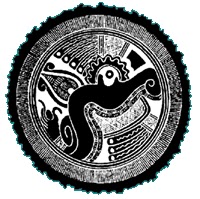Although many people only think of Laguna de Apoyo as a place to swim or to build a house, fascinating wildlife can still be found in its forests. Our
bird monitoring program, managed by the biologist Jeffrey McCrary in coordination with the Ministry of the Environment and Natural Resources (MARENA), is now in its fifth year, is intended to demonstrate what is important about this forest as a natural area. We have been very successful in identifying some of the more important places as bird habitat in the Laguna de Apoyo Nature Reserve. In one of the sites we study, a pair of Pale-billed Woodpeckers (
Campephylus guatemalensis) is regularly seen. Here is a picture of the female, taken by the
FUNDECI/GAIA intern Pauline Pearse.
 |
| Female Pale-billed Woodpecker in Laguna de Apoyo Nature Reserve, Nicaragua. Photo Pauline Pearse. |
Our list of birds documented inside
Laguna de Apoyo Nature Reserve now reaches well over 225 species. Although we are surveying only a small fraction of the 2500 hectares of land, well over a quarter of all the birds documented in Nicaragua have appeared here. We continue to press upon the authorities at MARENA and community to enforce policies against hunting, wood extraction, building and other land uses which destroy the habitats for birds like the Pale-billed Woodpecker. For instance, this bird is not found in the less mature forests on the north side of the lake, but rather only where there is a greater amount of intact, mature forest, in the southwest corner of the reserve. There are not so many places in Nicaragua where this glorious bird can be seen easily, so we are always happy to get a glimpse.
 |
| This juvenile Grey Hawk (Buteo nitidus) is a typical sighting in Laguna de Apoyo Nature Reserve. Photo Pauline Pearse. |
The documentation of biodiversity and the environmental effects on it by human activity requires detailed work, much of which is performed by the
conservation science interns at FUNDECI/GAIA. Their assistance in our
long-term bird studies is essential to understanding how an area so heavily used by humans can retain its qualities as a natural area for wildlife.
 |
| Laguna de Apoyo Nature Reserve is home for many birds, including the colonial nesting Montezuma Oropendola (Psaracolius montezuma). Photo Belen Camino. |
We recognize that the threats are palpable to these wild animals. For instance, on two occasions, the Montezuma Oropendola (
Psaracolius montezuma) colonies in the area have been affected by landowners destroying their nesting colonies. In many areas where houses are found, large trees that would attract the birds are downed, limiting the potential habitat for these and many other birds.
 |
| FUNDECI/GAIA conservation science intern, Ruben Pelckmanns, at work on a study of the motmots. Photo Pablo Somarriba. |
We are continuing to gather information on the
wildlife of the area, with the aid of visiting scientists, interns and volunteers. Our studies have recently been widened to consider nest sites, in which two of our
conservation science interns have participated. We invite interested people to contact us and participate in the study and protection of this special natural area.
 |
| Migratory birds such at the Summer Tanager (Piranga rubra) are important components of the birdlife in Laguna de Apoyo Nature Reserve. Photo Onno Bierman. |






No comments:
Post a Comment